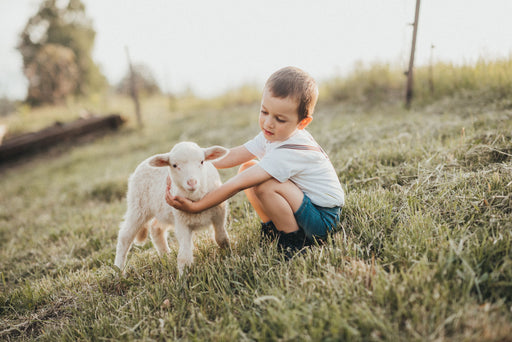Lambswool vs Merino Wool

Lambswool and Merino wool are both known for their softness and quality. Both wool types offer a soft and luxurious feel, can help regulate our body heat, are easy to clean, and available in many styles and colors. But,you may, like many of us, be stumped trying to figure out the difference between lambswool and Merino. Which is softer? Is one itchier than the other? Will lambswool or Merino wool keep you warmer? It's not as complicated as you may think; let’s explore and learn more about each of these wool types.
What is wool?
Before we begin exploring the differences between lambswool and Merino wool, let’s take just a few moments to review what wool is.
Wool is a fabric made using fleece from sheep, goats, rabbits, alpacas, and other camelids. Since each of these species (and even different breeds of the same species) have different fleece, the wool fabric made from shearing them will also be different.
One of the main differences in the fleece or hair from different animals lies in the diameter of the follicle. The measurement is reported in microns and tells a lot about how soft a wool fiber will feel. The micron count for wool, especially wool used to make clothing, is typically less than 40, but often lower than 25 for much softer wool types. Compare this to the micron count of human hair, which is between 40 and 90 microns, and you should start to get a good idea about why wool fabric feels so soft.

However, as we mentioned above, all wool is not the same; some have a lower micron count than others making them softer. Mohair is different from wool, and cashmere is different from wool as well, for example.
How do lambswool and Merino wool compare in this respect? Let’s take a look at the characteristics of each wool type in the next few sections.
Lambswool
Lamb are sheep under the age of 12 months. So, lambswool is just wool that has been sheared from these young lambs. Since lambs have softer fleece than adult sheep, when you compare lambswool vs wool, lambswool is softer than wool made from adult sheep of the same breed. Most young sheep are sheared for the first time when they are around seven months old. This first shearing of the lamb yields lambswool.
Now, while a lamb’s wool will be softer than an adult sheep’s wool, there is no set micron level for lambswool. Since lambswool simply comes from a young sheep, there will be a difference in the micron count depending on which type of sheep the wool came from. This is because different types of sheep (such as Merino sheep, Corriedale sheep, Blue Faced Leicester sheep, and Rambouillet sheep) have different wool. In fact, there are over 1,000 different sheep breeds, so it should be easy to imagine that there can be significant differences in how fine or coarse one particular breed’s fleece is.
Merino Wool
So, what is Merino wool, and how does it compare with wool? Merino is one breed of sheep, and Merino wool is the wool that is produced from shearing this breed. Merino sheep have very fine and soft fleece. Typically, the micron count for their wool has an average micron count of about 21.5, making it very soft indeed. In some cases, the micron count can be as low as 15, which can make some Merino wool as soft as Cashmere. Merino wool can be sheared from a Merino sheep at any point in their life; it isn’t necessarily obtained from the first shearing of a lamb.

When you’re comparing Merino wool and wool, Merino wool will almost always be softer since Merino sheep have such fine fleece. The difference between virgin wool and Merino wool is another question many individuals have. Virgin wool is simply wool that hasn’t been used before. Wool is a material that can be recycled and used again and again, but a ‘virgin wool’ garment or item is one that is made from freshly sheared wool. So, if softness is your main priority then Merino wool is the one to choose.
Lambswool vs Merino Wool
The big question many wool lovers will ask is whether lambswool or Merino wool is better.
As we shared above, lambswool is simply wool that comes from the first shearing of a young sheep. This means that its micron count and softness can vary significantly based on the specific sheep breed. Unless a lambswool garment has a label that indicates the micron count, it doesn’t really tell you enough to know just how soft the wool is. Since lambs have finer fleece than adults, lambswool is often classified as ultra fine or superfine, but again with so many different lamb species there can be a lot of variability.
There is nothing more frustrating than buying that new cozy wool sweater and finding that your first wear brings you out in hives! So is Merino wool or lambswool itchy?
This is another important difference to point out about these two types of wool. Lambswool is typically less itchy than wool made from most adult sheep, but depending on the specific breed of sheep (and how sensitive your skin is), it may still feel itchy and irritate your skin. Merino wool, however, doesn’t do this. . This is because the fibers are so fine that they bend when they come into contact with the skin. With coarser wool fibers, the fibers will stick out and essentially prick the skin, giving you that oh-so-itchy feeling.
Merino Wool vs Lambswool: Uses

The differences between Merino Wool and lambswool contribute to how each fiber type is used. Is Merino wool warmer than normal wool?
Since Merino wool is finer than normal wool, Merino wool garments are typically lighter weight. However, it still does have a high warmth to weight ratio and can act as a good insulator to keep you warm on a cold day. Merino wool is also very breathable, which can help you regulate your core temperature and stay more comfortable overall.
As we shared above, the diameter, or micron level, or Merino wool can vary some. This allows for more versatile uses including some very lightweight garments and items to warmer ones. As an example, you can find Merino wool dress socks as well as thicker, heavier-duty Merino wool socks to keep your feet warm in frigid temperatures. Some other garments frequently made using Merino wool include sweaters, scarves, mittens, and leg warmers.
Lambswool may feel a bit warmer than Merino wool since it has a higher micron count. Lambswool can be used to spin durable yarn suitable for use for a variety of items. Since lambswool is more elastic than wool made from adult sheep, garments made from it can keep their shape better. Lambswool is often used for making tops, such as jerseys, but scarves, hats, and gloves can also be made from it. Another common use for lambswool is adding padding for a variety of items, including pointe shoes for ballerinas.

Lambswool vs Merino Wool: Care and Cleaning
One of the benefits of wool fabrics is that they don’t hold onto odors like synthetic fabrics do. This means they do not need to be washed as regularly and can simply be aired out between uses. However, most of us appreciate clean clothing and after wearing a wool garment several times or if it becomes stained or soiled, you will want to wash it thoroughly.
With both Merino and lambswool, the best method for cleaning either fabric type is hand washing. This will help protect the fabric and help your garment to last for as long as possible.
To hand wash lambswool or Merino wool, fill a clean sink or basin with warm water. Add a gentle, wool-approved detergent to the water and gently stir to mix it in. Place your wool garment in and use your hand to gently agitate it. Allow the garment to soak for about 10 minutes.
Then, remove the garment from the basin, drain the water, and rinse any excess soap out of the basin. Fill the basin with fresh warm water and place the wool garment back in. Gently squeeze the garment to release the soap. Continue repeating these steps until all the soap has been removed from the wool and the water is clear.
The safest way to dry wool is to air dry it. After rinsing the soap out of the garment, lay it flat to dry on a clean towel. Hang drying is not advised, as it could cause the fabric to stretch out. You should also avoid placing wool items near direct sunlight or heat as it could make them shrink or
cause other damage.
For more on how to wash wool, read more on our blog!

Once dry, fold your wool items and store them in a drawer. Even when dry, wool can still stretch out if hung. Protecting wool from moths is also essential. Using moth traps will help eliminate a moth problem and cedar chips, or lavender sachets will deter moths from ruining your wool items. If you are not planning on wearing a wool garment in the near future, store it in an airtight plastic bin or archival box to keep it more protected.
Lambswool vs Merino Wool: Which Will You Acquire?
Both Merino wool and lambswool are very soft and warm fabrics. However, as you can see, there are some key differences between these two wool types that can affect how they are used and may impact which is the best fabric for you.
About MothPrevention
MothPrevention® speak to customers every day about their clothes moth issues - clothes moths are a species that are ever increasing and that can cause significant damage to clothes, carpets and other home textiles.
To date, we’ve helped over 250,000 customers deal with their moth problems. We have developed professional grade solutions including proprietary pheromones and trap design, not available from anybody else in the USA.





